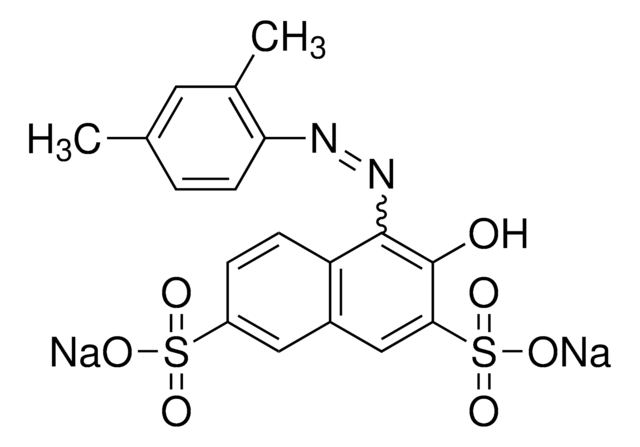Wichtige Dokumente
199656
Sudan II
Dye content 90 %
Synonym(e):
1-(2,4-Xylylazo)-2-naphthol, Solvent Orange 7
Größe auswählen
About This Item
Empfohlene Produkte
Form
powder
Qualitätsniveau
Zusammensetzung
Dye content, 90%
mp (Schmelzpunkt)
156-158 °C (lit.)
Löslichkeit
chloroform: 10 mg/mL
λmax
493 nm
604 nm (2nd)
ε (Extinktionskoeffizient)
≥14000 at 491-497 nm in methanol at 0.005 g/L
≥9000 at 419-425 nm in methanol at 0.005 g/L
Anwendung(en)
diagnostic assay manufacturing
hematology
histology
Lagertemp.
room temp
SMILES String
Cc1ccc(\N=N\c2c(O)ccc3ccccc23)c(C)c1
InChI
1S/C18H16N2O/c1-12-7-9-16(13(2)11-12)19-20-18-15-6-4-3-5-14(15)8-10-17(18)21/h3-11,21H,1-2H3/b20-19+
InChIKey
JBTHDAVBDKKSRW-FMQUCBEESA-N
Suchen Sie nach ähnlichen Produkten? Aufrufen Leitfaden zum Produktvergleich
Verwandte Kategorien
Anwendung
Biochem./physiol. Wirkung
Signalwort
Warning
H-Sätze
Gefahreneinstufungen
Eye Irrit. 2 - Skin Irrit. 2 - Skin Sens. 1
Lagerklassenschlüssel
11 - Combustible Solids
WGK
WGK 2
Flammpunkt (°F)
448.9 °F - closed cup
Flammpunkt (°C)
231.6 °C - closed cup
Persönliche Schutzausrüstung
dust mask type N95 (US), Eyeshields, Gloves
Hier finden Sie alle aktuellen Versionen:
Analysenzertifikate (COA)
Die passende Version wird nicht angezeigt?
Wenn Sie eine bestimmte Version benötigen, können Sie anhand der Lot- oder Chargennummer nach einem spezifischen Zertifikat suchen.
Besitzen Sie dieses Produkt bereits?
In der Dokumentenbibliothek finden Sie die Dokumentation zu den Produkten, die Sie kürzlich erworben haben.
Kunden haben sich ebenfalls angesehen
Aktive Filter
Unser Team von Wissenschaftlern verfügt über Erfahrung in allen Forschungsbereichen einschließlich Life Science, Materialwissenschaften, chemischer Synthese, Chromatographie, Analytik und vielen mehr..
Setzen Sie sich mit dem technischen Dienst in Verbindung.











